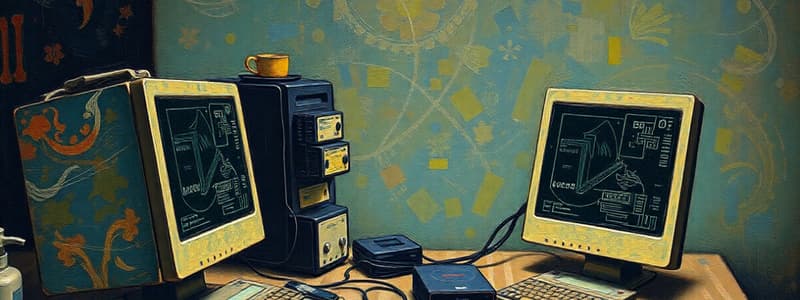Podcast
Questions and Answers
Which of the following is NOT considered a peripheral device in a desktop computer?
Which of the following is NOT considered a peripheral device in a desktop computer?
- Operating System (correct)
- Printer
- Keyboard
- Monitor
What is the primary function of the operating system (OS) on a desktop computer?
What is the primary function of the operating system (OS) on a desktop computer?
- Storing data on hard drives
- Displaying images on the monitor
- Creating and editing documents
- Managing the computer's hardware and software (correct)
Which of these is an example of an application software?
Which of these is an example of an application software?
- Microsoft Word (correct)
- macOS Big Sur
- Linux Ubuntu
- Windows 10
What is the main function of a microphone in a desktop computer setup?
What is the main function of a microphone in a desktop computer setup?
Which of the following is NOT a primary function of ICT in desktop computers?
Which of the following is NOT a primary function of ICT in desktop computers?
Which of these components is NOT a part of the computer's central processing unit (CPU)?
Which of these components is NOT a part of the computer's central processing unit (CPU)?
What is the main function of the motherboard in a desktop computer?
What is the main function of the motherboard in a desktop computer?
Which component is primarily responsible for displaying images and videos on the computer screen?
Which component is primarily responsible for displaying images and videos on the computer screen?
Which of the following components provides the power supply needed for the computer to function?
Which of the following components provides the power supply needed for the computer to function?
Which type of storage device is known for its speed and durability, making it ideal for booting the operating system?
Which type of storage device is known for its speed and durability, making it ideal for booting the operating system?
Flashcards
Central Processing Unit (CPU)
Central Processing Unit (CPU)
The brain of the computer that executes instructions and calculations.
Motherboard
Motherboard
Main circuit board connecting all components, enabling communication.
Random Access Memory (RAM)
Random Access Memory (RAM)
Temporarily stores data for quick access by the CPU, allowing multitasking.
Graphics Processing Unit (GPU)
Graphics Processing Unit (GPU)
Signup and view all the flashcards
Hard Disk Drive (HDD) / Solid State Drive (SSD)
Hard Disk Drive (HDD) / Solid State Drive (SSD)
Signup and view all the flashcards
Monitor
Monitor
Signup and view all the flashcards
Operating System (OS)
Operating System (OS)
Signup and view all the flashcards
Data Processing
Data Processing
Signup and view all the flashcards
Applications
Applications
Signup and view all the flashcards
Peripheral Devices
Peripheral Devices
Signup and view all the flashcards
Study Notes
Desktop ICT Components
- Desktop computers are a type of personal computer assembled from various hardware components, each with a specific function.
- These components work together to form a complete system capable of processing information and tasks.
Essential Hardware Components
- Central Processing Unit (CPU): The computer's brain, executing instructions and performing calculations. It determines the computer's processing speed.
- Motherboard: The main circuit board connecting all components, enabling communication and coordinated operation. It houses slots for expansion cards, ports, and the CPU socket.
- Random Access Memory (RAM): Temporary storage for data and instructions used by the CPU. More RAM allows for smoother multitasking.
- Graphics Processing Unit (GPU): Dedicated to graphical processing and display, offloading the CPU for other tasks. More powerful GPUs handle graphics-intensive applications (e.g., gaming, video editing).
- Hard Disk Drive (HDD) or Solid State Drive (SSD): Permanent storage for programs and files. SSDs are faster and more durable than HDDs. Storage capacity is measured in gigabytes (GB) or terabytes (TB).
- Power Supply Unit (PSU): Converts AC to DC power for computer components. Sufficient power is crucial for all components.
- Optical Drives (Optional): CD/DVD drives for reading and writing data on optical discs. Less common now.
- Input Devices: Keyboard, mouse, webcam, microphone, and other peripherals, providing commands and data input.
- Output Devices: Monitor (screen), speakers, printers; displaying processed or generated information to the user.
Peripheral Devices
- Monitor: Visually displays computer-processed information.
- Keyboard: Allows users to input text and commands.
- Mouse: Controls the cursor and enables interaction with screen objects.
- Printers: Create hard copies of documents or images.
- Webcam: Captures video for video conferencing.
- Microphone: Allows audio input.
- Speakers: Output sound.
Software Components
- Operating System (OS): Core software managing hardware (CPU, memory), providing a user interface, and running applications. Examples include Windows, macOS, and Linux.
- Applications: Programs for specific tasks like word processing, web browsing, or photo editing.
ICT (Information and Communication Technology) in Desktop Computers
- ICT encompasses the technologies and processes for managing, sharing, and utilizing information and communication within a desktop setting. This includes networking and data management practices.
Desktop ICT Functions
- Data Processing: Performing calculations, organizing data, and creating reports.
- Communication (limited in a single desktop): Connecting via networks to remote servers or computers. The desktop itself isn't a primary communication hub.
- Data Storage: Maintaining files and data for future access and use.
- Automation: Using software and hardware to automate tasks or processes (e.g., scripts).
- Information Retrieval: Searching and finding relevant information from stored data.
Studying That Suits You
Use AI to generate personalized quizzes and flashcards to suit your learning preferences.




